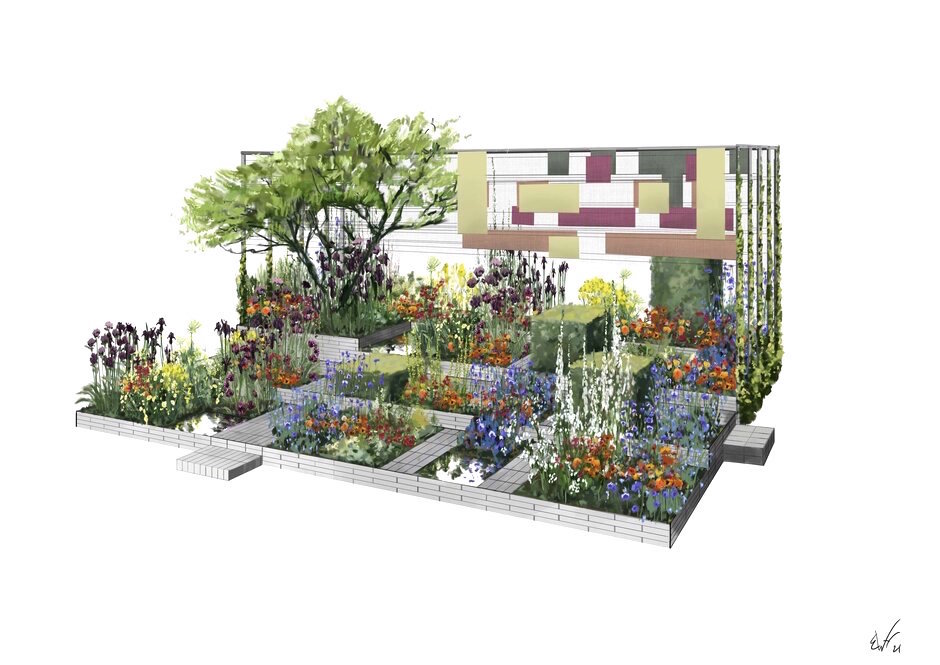Gardening for the future of fashion: Fashion Revolution at RHS Chelsea Flower Show

Plants, left to right: pale blue Iris pallida, salmon-pink valerian, spherical white alliums with nettles in front, purple alliums with chives in front, frothy yellow-flowered woad and dark purple Iris ‘Langport Wren’
Plants and fashion have been linked for millennia. Plants give us natural fibres for fabrics: cotton, bamboo, linen from flax are obvious examples – less obvious is the nettle family, which gives us ramie, and has been used for at least 6,000 years. Colour has historically come from plants, until Victorian times and the invention of chemical dyes. And plants and flowers inspire fabric patterns, too. In our global world this traditional connection has been lost, and what we wear is likely to be created thousands of miles away using fossil fuels and toxic chemicals, which are harmful to our health and the environment.
One garden at the 2022 RHS Chelsea Flower Show is examining these centuries-old connections between what we grow and what we wear, and how we can improve this relationship. First-time Chelsea Flower Show exhibitor Lottie Delamain is a former textile designer, who wants to use her Show garden, called A Textile Garden for Fashion Revolution, to showcase creative possibilities and innovative thinking, and help to re-establish the connection between plants and textiles, reveal the beauty to be found in plant-based dyes and fibres, and sow a seed of curiosity about what we wear.

Lottie Delamain
The garden is sited in the All About Plants section, new this year, and is in support of Fashion Revolution, a fashion activism movement whose mission is to radically change the way we source, produce and consume fashion around the world. The garden is funded by Project Giving Back, a philanthropic organisation that supports gardens for good causes.
If you’re looking for trends to take away, the fabric panels are an easy-to-emulate idea; think banners, bunting, prayer flags, which all bring colour and movement to a garden. Water features, which can be as simple as a regularly topped-up bowlful, add reflective views of sky and surrounding plants and flowers.

Woven willow cubes evoke the texture of fabric. Willow bark is used for dyeing pink and reds. In front of the willow cubes is a staghorn sumac tree (Rhus typhina), which gives brown and rust shades
Plants used include historic dye plants such as woad (Isatis tinctoria), which is a frothy, lemon-yellow flower used for blue dye, and madder (Rubia tinctorum), also yellow-flowered, for shades of red. You’ll recognise other species, like spherical-headed alliums (Allium nigrum, Allium atropurpureum), from the onion family, which give a rich brown colour, orange-petalled calendula (Calendula ‘Indian Prince’, ‘Neon’ and ‘Sunset Buff’), which give orange shades, cornflowers (Centaurea cyanus) and irises (Iris pallida, Iris ‘Langport Wren’) for shades of black, blue and grey, and pink-flowered valerian (Centranthus ruber ‘Albus’) for shades of green.
And several plants’ historic role in colouring clothes is revealed by their common names, like dyer’s woodruff (Asperula tinctoria – reds), dyer’s chamomile (Anthemis tinctoria ‘E.C. Buxton’ – yellows) and dyer’s broom (Genista tinctoria – yellows).

Many of the plants are native wildflowers, easily propagated and grown in the UK and undemanding in terms of water.
The aim of the garden is to encourage those who see it to be inspired by plants that can be used to make natural dyes and fibres, try dyeing with plants at home, or even create a mini-dye garden, and think about the plants that they might be wearing and, ultimately, ask #WhatsInMyClothes?, a hashtag created by Fashion Revolution.

As with fashion design, a finished Chelsea Show garden begins with a sketch…
Adrienne Wyper is a health and lifestyle writer and regular TNMA contributor.
I love this. I once went to the Lowell Textile museum where they have videos of topics like Flax and thought it was very cool! I love clothes and the the natural fabrics. They feel wonderful to wear! People never really think about this in modern life. Thanks for bringing it to light!